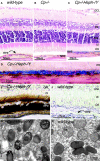Retinal iron homeostasis in health and disease
- PMID: 23825457
- PMCID: PMC3695389
- DOI: 10.3389/fnagi.2013.00024
Retinal iron homeostasis in health and disease
Abstract
Iron is essential for life, but excess iron can be toxic. As a potent free radical creator, iron generates hydroxyl radicals leading to significant oxidative stress. Since iron is not excreted from the body, it accumulates with age in tissues, including the retina, predisposing to age-related oxidative insult. Both hereditary and acquired retinal diseases are associated with increased iron levels. For example, retinal degenerations have been found in hereditary iron overload disorders, like aceruloplasminemia, Friedreich's ataxia, and pantothenate kinase-associated neurodegeneration. Similarly, mice with targeted mutation of the iron exporter ceruloplasmin and its homolog hephaestin showed age-related retinal iron accumulation and retinal degeneration with features resembling human age-related macular degeneration (AMD). Post mortem AMD eyes have increased levels of iron in retina compared to age-matched healthy donors. Iron accumulation in AMD is likely to result, in part, from inflammation, hypoxia, and oxidative stress, all of which can cause iron dysregulation. Fortunately, it has been demonstrated by in vitro and in vivo studies that iron in the retinal pigment epithelium (RPE) and retina is chelatable. Iron chelation protects photoreceptors and retinal pigment epithelial cells (RPE) in a variety of mouse models. This has therapeutic potential for diminishing iron-induced oxidative damage to prevent or treat AMD.
Keywords: age-related macular degeneration (AMD); ceruloplasmin; chelator; ferroportin; hephaestin; iron; oxidative stress; retina.
Figures



References
-
- Baker E., Morgan E. H. (1994). Iron transport, in Iron Metabolism in Health And Disease, eds Brock J., Halliday J. H., Pippard M. H., Powell L. W. (Philadelphia, PA: W. B. Saunders; ), 63–95
Grants and funding
LinkOut - more resources
Full Text Sources
Other Literature Sources
Research Materials

